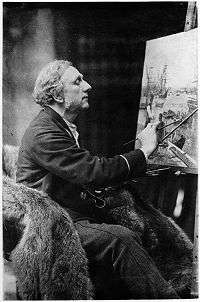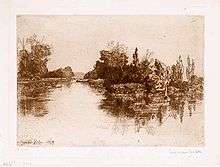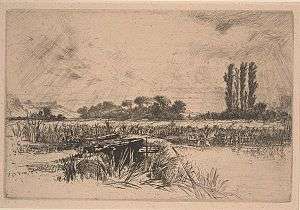Francis Seymour Haden

Sir Francis Seymour Haden (16 September 1818 – 1 June 1910), was an English surgeon, best known as an etcher.
Life
He was born in London, his father, Charles Thomas Haden, being a well-known doctor and lover of music. He was educated at Derby School, Christ's Hospital, and University College, London, and also studied at the Sorbonne, Paris, where he took his degree in 1840. He was admitted as a member of the College of Surgeons in London in 1842.[1]
Artistic career
In 1843–44, with his friends Duval, Le Cannes and Colonel Guibout, he travelled to Italy and made his first sketches from nature. Haden attended no art school and had no art teachers, but between 1845 and 1848 he studied portfolios of prints belonging to a second-hand dealer named Love, who had a shop in Bunhill Row, the old Quaker quarter of London. Arranging the prints in chronological order, he studied the works of the great original engravers, Albrecht Dürer, Lucas van Leyden and Rembrandt.[1]
Haden's printmaking was invigorated by his much younger brother-in-law, James McNeill Whistler, at the Haden home in Sloane Street in 1855. A press was installed there and for a while Haden and Whistler collaborated on a series of etchings of the Thames. The relationship and project did not last.[2]

(1869)
Haden followed the art of original etching with such vigour that he became not only the foremost British exponent of that art but brought about its revival in England. His strenuous efforts and perseverance, aided by the secretarial ability of Sir WR Drake, resulted in the foundation of the Royal Society of Painter-Etchers and Engravers. As president he ruled the society with a strong hand from its first beginnings in 1880.[1]
Notwithstanding his study of the old masters of his art, Haden's own plates were very individual.[1] He preferred to work directly onto the plate in front of the subject.[3] Malcolm Salaman wrote of Haden drawing from nature "with that breadth, freedom, and spontaneity of effect, which, while suggesting a sketch, represented a true etcher's drawing".[3] Even when working from a picture by another artist his personality dominates the plate, as for example in the large plate he etched after J.M.W. Turner's Calais Pier, which is a classical example of what interpretative work can do in black and white. Of his original plates, more than 250 in number, one of the most notable was the large Breaking up of the Agamemnon.
An early plate, rare and most beautiful, is Thames Fisherman. Mytton Hall is broad in treatment, and a fine rendering of a shady avenue of yew trees leading to an old manor-house in sunlight. Sub Tegmine was etched in Greenwich Park in 1859; and Early Morning--Richmond", full of the poetry and freshness of the hour, was done, according to Haden, actually at sunrise. One of the rarest and most beautiful of his plates is A By-Road in Tipperary; Combe Bottom is another; and Shere Mill Pond (both the small study and the larger plate), Sunset in Ireland, Penton Hook, Grim Spain and Evening Fishing, Longparish are also notable examples of his work. A catalogue of his works was begun by Sir William Drake and completed by Harrington in 1880. During later years also Haden began to practise mezzotint engraving, with a measure of the same success that he had already achieved in pure etching and in dry-point. His mezzotints include An Early Riser, a stag seen through the morning mists, Grayling Fishing and A Salmon Pool on the Spey. He also produced some charcoal drawings of trees and park-like country.[1]
Writings
Haden's studies of Rembrandt, besides influencing his original work, led to his important monograph on the Dutch artist's etchings. Through books and lectures, and with the aid of an exhibition at the Burlington Fine Arts Club in 1877, he tried to give a true reflection of Rembrandt's work,[1] excluding from his oeuvre a large number of plates previously attributed to him.[4] Haden's reasons were founded upon the results of a study of the master's works in chronological order, and are clearly expressed in his monograph, The Etched Work of Rembrandt critically reconsidered, privately printed in 1877, and in The Etched Work of Rembrandt: True and False (1895).[1]

Other books by Haden not already mentioned are:
- Etudes a l'eau forte (Paris, 1865) x
- About Etching (London, 1878-1879)
- The Art of the Painter-Etcher (London, 1890)
- The Relative Claims of Etching and Engraving to rank as Fine Arts and to be represented in the Royal Academy (London, 1883)
- Address to Students of Winchester School of Art (Winchester, 1888)
- Cremation: a Pamphlet (London, 1875)
- The Disposal of the Dead, a Plea for Legislation (London, 1888).
As the last two indicate, he was an ardent champion of a system of "earth to earth" burial.[1] During the London 'Burial Crisis' of the late 1840s, following several epidemics, he aired a proposal to ship the bodies of London's dead to the Thames Estuary for use in land reclamation but this met with little approval.[5]
Honours
Among numerous distinctions he received the Grand Prix, Paris, in 1889 and 1900, and was made a member of the Institut de France, Académie des Beaux-Arts and Société des Artistes Français. He was knighted in 1894.
Family
In 1847 he married a half-sister of the artist James McNeill Whistler (the siblings sharing the same father only); and his elder son, Francis Seymour Haden (b. 1850), had a distinguished career as a member of the government in Natal Colony from 1881 to 1893, being made a C.M.G. in 1890.[1]
Bibliography
- A Catalogue Raisonné of the Prints of Sir Francis Seymour Haden by Dr Richard S. Schneiderman (1983) ISBN 978-0-9060-3016-5.
References
- 1 2 3 4 5 6 7 8 9
 One or more of the preceding sentences incorporates text from a publication now in the public domain: Chisholm, Hugh, ed. (1911). "Haden, Sir Francis Seymour". Encyclopædia Britannica (11th ed.). Cambridge University Press.
One or more of the preceding sentences incorporates text from a publication now in the public domain: Chisholm, Hugh, ed. (1911). "Haden, Sir Francis Seymour". Encyclopædia Britannica (11th ed.). Cambridge University Press. - ↑ Garton & Co.
- 1 2 Salaman, Malcolm (1917). Graphic Arts of Great Britain. London: Studio. p. 57.
- ↑ Woodfield, E.H. Gombrich ; edited by Richard (1987). Reflections on the history of art : views and reviews (1. ed.). Berkeley: University of California Press. p. 138. ISBN 9780520061897.
- ↑ Arnold, Catherine (2006). Necropolis: London and its dead. Simon & Schuster. p. 160.
 This article incorporates text from a publication now in the public domain: Chisholm, Hugh, ed. (1911). "Haden, Sir Francis Seymour". Encyclopædia Britannica. 12 (11th ed.). Cambridge University Press. pp. 797–798.
This article incorporates text from a publication now in the public domain: Chisholm, Hugh, ed. (1911). "Haden, Sir Francis Seymour". Encyclopædia Britannica. 12 (11th ed.). Cambridge University Press. pp. 797–798.
External links
| Wikimedia Commons has media related to Francis Seymour Haden. |
- Sir Francis Seymour Haden at artoftheprint.com
- H. Nazeby Harrington: The Engraved Work of Sir Francis Seymour Haden, P.R.E. An Illustrated and Descriptive Catalogue. Henry Young & Sons, Liverpool 1910.